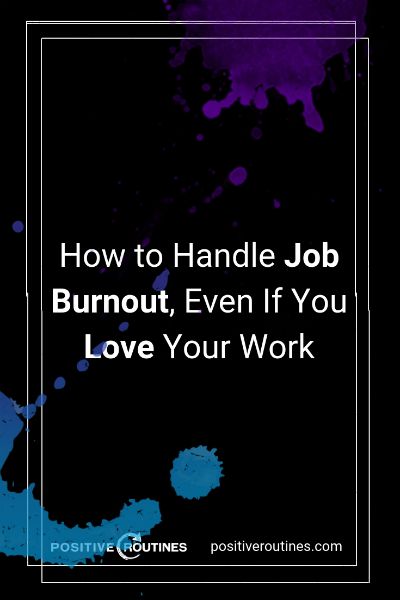Here in the US, most of us spend more time on work than we do on nearly anything else, which is partially why job burnout exists in the first place. It’s also why work burnout is so all-encompassing when it hits—and so hard to overcome. But it doesn’t have to be that way. Whether you want to prevent burnout before it happens, wonder what the science says about how to overcome it, or need some strategies to reclaim your confidence and happiness at work, we’ve got you covered in our guide to job burnout.
The Comprehensive Guide to Job Burnout

Here are the topics we’re taking on:
- The definition of burnout
- Why burnout happens in the first place
- Why are you burned out? Answer these questions to find out
- How common is burnout?
- What burnout looks like: Signs and symptoms
- Thoughts and actions of burnout: An example
- How to deal with burnout at work
A little disclaimer: It’s easy to get carried away while reading about negative situations. Who hasn’t experienced occasional moments—or weeks—of not-so-great feelings about work? Think of this guide as a resource, but don’t panic if you’re seeing yourself in some of these behaviors or feelings, especially if you haven’t noticed them before. Work is work, and it’s okay for it to be unpleasant sometimes.
Without further ado, here is our guide to everything you need to know about job burnout.
1. The definition of job burnout

So what is burnout exactly? According to research, job burnout is how your body and brain react under chronic stress at work. There are three different aspects of it, and you only need one to be feeling the effects, though many people have all three. (Lucky them.)
Here are the dimensions of burnout:
- Exhaustion: Burnout isn’t just in your head; it’s also in your body. And it makes you tired all the time. As in every day.
- Cynicism: You feel a lot of negativity about your work, which doesn’t mean you’re a bad person or employee. That cynicism has a purpose—it’s a way to cope with stress and distance yourself from your job. If you’re struggling with negative thoughts, you might not care about the quality or outcome of your work. Or even the people you work with.
- Inefficacy: Your confidence and performance at work go down. You doubt yourself and your abilities, aren’t in the best mood, and aren’t as productive or effective at your job.
2. Why does job burnout happen?

A lot of things cause job burnout, and we can’t possibly get into every single one of them here. We can, however, dig into some of the ways researchers categorize and understand them. Some of these are circumstantial, and others are more personality-based. Take a look and see if you recognize any of these in your job or in yourself. And don’t worry—we’re going to talk about how to deal with some of these too. You didn’t think we’d leave you hanging like that, did you?
Factors that are about your role + work environment

Here are some situational factors that add to burnout, according to a classic research review of 25+ years of studies on the subject.
- Overload: You have too much work to do in too little time.
- Role ambiguity: You’re unclear about your expectations.
- Role conflict: You have competing demands.
- Limited social support: You lack the camaraderie of your colleagues, and more importantly, you have little support from supervisors.
- Little to no feedback: You’re not getting any information about your performance.
- Lack of autonomy: You don’t feel in control of your work and aren’t included in decision-making processes.
Factors that are about you

Some personality traits and ways of thinking influence your likelihood of experiencing burnout. Just to be clear—this isn’t a blame game. It’s helpful to know your risk in order to help keep burnout at bay. Let’s take a look at how individual factors might contribute to overwhelm at work.
- People with an external locus of control: If you have an external locus of control, you tend to think that events in your life are due to chance, so you can’t change them. This kind of thinking increases your chances of burnout.
- People with high levels of neuroticism: Neuroticism (i.e., being generally anxious and negative) makes you more likely to suffer from all aspects of job burnout.
- Introverts: Introverts are more likely to experience burnout, especially when it comes to inefficacy.
- People who are less agreeable, conscientious, and open to experiences: People with low scores for the agreeableness (warmth and optimism), conscientiousness (being careful and organized), and openness to new experiences also struggle more with burnout.
- Younger workers: Workers under 30 are more likely to experience burnout compared to those of us 30+.
- Single workers: People without spouses are more likely to burn out than their married colleagues.
3. Why are you burned out? Answer these questions to find out

For many people, both situational and individual factors create a mismatch with a given job. The questions below, based on this research, help you think about how your personality interacts with your work, which can tell you if and why you’re feeling burned out.
Answer these to see where the balance is off in your current work situation.
- Workload: Do you have enough time and information to get your work done? Does your work match your skills and interests?
- Control: Are you allowed to go about your work in the most effective way or a way that works best for you? Are the expectations about results things you can control?
- Reward: Do you get rewarded for your achievements, either by praise, financial compensation, or another means? Do those rewards cover your social, financial, and personal needs?
- Community: Do you have a sense of connection and support with the other people in your workplace?
- Fairness: Are people treated fairly at your workplace?
- Values: Does your daily work line up with your personal values? Do your organization’s stated values line up with the actual practice?
4. How common is burnout?

Pretty common, though it’s important to note that a lot of the studies on burnout are linked to specific jobs. Let’s take a look at what’s out there.
- Emergency nurses experience about a 30 percent rate of job burnout.
- A separate study of a wider range of healthcare professions found a burnout rate of 8 percent.
- A less formal survey conducted by Deloitte has even more alarming results: 77 percent of American professionals have experienced job burnout at least once at their current jobs, and 51 percent have experienced it more than once.
Before you get too frustrated with the figures, you can interpret these stats as comforting. Why? Because it means that a little burnout is totally normal. Want even more optimism? In that same Deloitte survey, 87 percent of workers reported being passionate about their jobs. So maybe burnout is just a side effect of really loving our work, in which case, we just need to know how to deal with it.
5. What are the signs of burnout?

How do you know when you’re getting burned out? When does that burnout dip into chronic territory? Some of the signs and symptoms below can help answer those questions.
The latest research looks at the practical signs of burnout and breaks them into a few profiles. These profiles are similar to the dimensions of burnout, and they don’t always occur in sequence. However, there is one that tends to show up first—exhaustion. No surprises there.
- Engaged: This is the best-case scenario: If you’re engaged, you’re low on all three dimensions of burnout. In other words, you’re doing great. Keep at it.
- Overextended: If you’re overextended, you’re high in exhaustion only. (“Only” being high in just one of the burnout dimensions. We all know that exhaustion is pretty, well, exhausting.)
- Ineffective: If you’re in this phase, you doubt your own abilities and are high in inefficacy only. This profile is by far the most common form of burnout.
- Disengaged: This is where things start to go further south. In the disengaged phase, you’re high in cynicism only. You’re closing in on full burnout.
- Full-on burnout: In this worst-case scenario, you’re high in all dimensions of burnout. And you need some relief. (We’ll get to that soon, promise.)
In terms of physical or mental symptoms of burnout, they range from insomnia to stomach issues to feelings of depression and sadness. Psychology Today breaks down some more symptoms here. Take a look, and be sure to reach out for professional help in your area if these symptoms are severe.
6. What burnout looks like in real life: An example

Still not sure if you have burnout? Another way to tell is to look at your patterns of thoughts and behavior at work. They’ll give you great insight into where you are on the burnout spectrum and if it’s time to get some help. Remember, occasional feelings of burnout are a normal part of working life for many people. But when burnout becomes a pattern, it can build up into a serious problem over time.
Here’s what that pattern might look like:
Daily job demands → daily exhaustion → self-undermining behavior→ more daily job demands tomorrow
Let’s walk through an example:
- A burned out worker, let’s call him Carl, is already tired and doubts his abilities to get work done. What Carl used to be able to do in a day now seems, and is actually experienced as, more demanding and exhausting.
- As the day goes on, Carl’s exhaustion doesn’t get any better. Carl screws something up; he makes more mistakes than he usually would. And those mistakes cost him time.
- Because he’s trying to get through his work, Carl turns down invites to grab drinks with coworkers after work or lunch during the day. He’s losing social support—and we know that social support is super important.
- Once Carl goes home, he’s not sleeping well. Most nights, he tosses and turns, leaving him more tired the next day.
- Carl isn’t intentionally isolating himself or making errors on the job, but his actions fall under self-undermining behavior.
- He only feels more behind and frustrated the next day, which starts the loop all over again.
Sounds fun, right? Not really. We’ve all got a little of Carl in us; the key, then, is how to break the cycle.
7. What to do when burnout strikes
So we know what burnout is, what causes it, how common it is, what it looks like, and the loop of doom. Now we need to know what to do about it.
Craft your job

Just like the negative burnout cycle, there’s an equally powerful job cycle that can put you back on track. It starts by getting re-engaged with your work. We know that sounds easier said than done, but there are science-backed ways to go about it. One of them is job crafting, i.e., taking an active role in your work by shifting your thinking and being proactive.
When you craft your job, you increase your daily job resources, which then increases your engagement the next day. And you suddenly, the loop of doom is now a loop of delight. Too far? Okay, it’s at least not a loop of doom anymore.
So how do you do it?
- Craft your tasks: Take on more tasks you like and less of the ones that you don’t. Or figure out how to incorporate more of the things you enjoy in your daily work.
For example: Love people but trapped at your desk all day? Mentor younger colleagues. Or talk to your boss about the best ways to use your skills/interests to make changes to your responsibilities. - Craft your relationships: You probably have to spend time in the office with people you don’t love. But you can also add time with people you do like.
For example: Take a coffee or lunch break together or figure out how to collaborate on a project. After all, you spend time with people you like outside of work, so why not do it at work too? - Craft your mindset: See also: Focusing on your work’s impact. It may not be immediately obvious, but reframing your work can boost positivity.
For example: If you’re an accountant, think about how helping people get bigger tax refunds allows them to afford the things they need.
What job crafting looks like in real life: An example
- An engaged worker, let’s call her Carla, arrives at the workplace rested and expecting to work.
- Carla gets to work, and she also thinks optimistically about little ways to fine-tune her job to better suit her own abilities, needs, and preferences.
- She knows she needs some interaction with real people, so she decides to chat with a coworker in person instead of through an email.
- Carla really likes to make complex analytics more visual for her number-confused colleagues, so she asks her supervisor for more opportunities to do that in a way that helps the rest of the team.
- She also decides to make a little game out of the day’s work, as a way to approach her tasks from a more playful perspective.
As you can see, none of these steps are particularly dramatic, but they involve positive thinking. They also incrementally build toward greater actual job resources, including social support, useful feedback from supervisors, and new opportunities to develop skills. These daily job resources make it a little bit easier to jump right back into engagement the next day and continue the happy cycle.
Call in the big guns—the professionals

There are two ways to get some professional help overcoming burnout—1. work within your organization and 2. use outside support. Let’s take a look at both options.
Talk to your organization

Here’s some good news: Organizations are now taking burnout seriously. And it’s about time. Truthfully, both of your interests are the same—they want engaged and productive workers whose roles match their skill sets and desires. And you want to be those workers. But they won’t be able to help you unless you tell them about it.
If you have a way to formally express your concerns about job burnout to your supervisor or human resources department, you could see meaningful changes in your life at work. Of course, you have to be strategic and diplomatic about it. Think about those circumstantial factors we discussed above and your answers to the job mismatch questions to identify where things don’t line up. Then, talk about those specific concerns.
Some of the options for resolution include job engagement workshops, individual therapy, changing your role within the organization, or even organization-wide intervention programs. Yup, those exist.
Seek outside support

Not comfortable talking to your employer about your burnout? That’s okay. There are still ways to get some relief. Find a therapist who can give you a burnout recovery plan and explore your individual thoughts and feelings that contribute to burnout. Cognitive behavioral therapists, in particular, are trained to help you identify and gradually transform harmful thought patterns into positive ones—potentially giving a professional boost to your personal job crafting efforts. Mindfulness and other forms of therapy can help as well.
Take action to avoid and deal with job burnout

Job burnout can happen to anyone, no matter how much you love your work. So it helps to know what to look for in order to tackle it head-on. We hope this guide helped you understand burnout better and gave you the tools and info you need to keep burnout from bringing you down.
Let’s end with a reminder: Time is too precious to spend it suffering at work. While job crafting is an effective strategy if your values and skills line up with your current work, it’s possible that your burnout is a sign that it’s time to move on. So dig in deeply, ask yourself the questions, pay attention to the answers, and know when to call it. After all, you deserve to enjoy the work you do. We all do.
Your turn: Tell us about a time you were bogged down with job burnout. What did you do? Share in the comments.
For more ways to be positive at work, try these science-backed strategies.

Author: Scott Trimble
Scott researched human motivation at The University of Texas at Austin. He spends most of his time traveling, reading, teaching, and writing.


Let Us Know What You Think